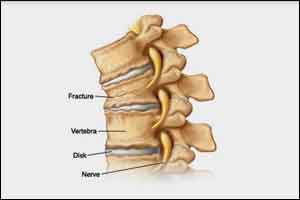- Home
- Editorial
- News
- Practice Guidelines
- Anesthesiology Guidelines
- Cancer Guidelines
- Cardiac Sciences Guidelines
- Critical Care Guidelines
- Dentistry Guidelines
- Dermatology Guidelines
- Diabetes and Endo Guidelines
- Diagnostics Guidelines
- ENT Guidelines
- Featured Practice Guidelines
- Gastroenterology Guidelines
- Geriatrics Guidelines
- Medicine Guidelines
- Nephrology Guidelines
- Neurosciences Guidelines
- Obs and Gynae Guidelines
- Ophthalmology Guidelines
- Orthopaedics Guidelines
- Paediatrics Guidelines
- Psychiatry Guidelines
- Pulmonology Guidelines
- Radiology Guidelines
- Surgery Guidelines
- Urology Guidelines
Type 2 diabetes patients more likely to develop vertebral fracture: Diabetes Care

Delhi: People with type 2 diabetes (T2D) are 55% more likely to experience vertebral fracture (VF) than people without T2D, finds a recent study published in the Diabetes Care journal. The study further found that T2D patients who sustain vertebral fractures are at a higher risk of death than T2D patients who do not sustain vertebral fractures.
According to the study findings, T2D patients should be systematically assessed for the presence of VFs. In people without T2D, the presence of VF constitutes an indication to start the treatment for osteoporosis for the prevention of future fractures.
Fjorda Koromani, from the Erasmus University Medical Center in Rotterdam, Netherlands, and colleagues aimed to assess whether individuals with type 2 diabetes (T2D) have an increased risk of vertebral fractures (VFs) and to estimate nonvertebral fracture and mortality risk among individuals with both prevalent T2D and VFs.
For the purpose, the researchers searched the online databases to identify the studies that investigated the relationship between T2D and VFs. Cohorts providing individual-participant data (IPD) were also included. A total of 15 studies comprising 852,705 men and women were included.
Read Also: Diabetes drug: Thiazolidines increase fracture risk in elderly diabetics
Key findings of the study include:
- Individuals with T2D had a lower risk of prevalent (odds ratio [OR] 0.84) but increased risk of incident VFs (OR 1.35).
- In the IPD cohorts (N = 19,820), the risk of nonvertebral fractures was higher in those with both T2D and VFs compared with those without T2D or VFs (hazard ratio [HR] 2.42, with VFs (HR 1.73), or T2D (HR 1.94) alone.
- Individuals with both T2D and VFs had increased mortality compared with individuals without T2D and VFs (HR 2.11) or with VFs alone (HR 1.84) and borderline increased compared with individuals with T2D alone (HR 1.23).
Read Also: Diabetes increases risk of fractures in those who are frail, finds study
"Based on our findings, individuals with T2D should be systematically assessed for the presence of VFs, and, as in individuals without T2D, their presence constitutes an indication to start osteoporosis treatment for the prevention of future fractures," the authors write.
More Information: "Vertebral Fractures in Individuals With Type 2 Diabetes: More Than Skeletal Complications Alone" published in the Diabetes Care journal.
DOI: https://doi.org/10.2337/dc19-0925
Journal Information: Diabetes Care

Disclaimer: This site is primarily intended for healthcare professionals. Any content/information on this website does not replace the advice of medical and/or health professionals and should not be construed as medical/diagnostic advice/endorsement or prescription. Use of this site is subject to our terms of use, privacy policy, advertisement policy. © 2020 Minerva Medical Treatment Pvt Ltd